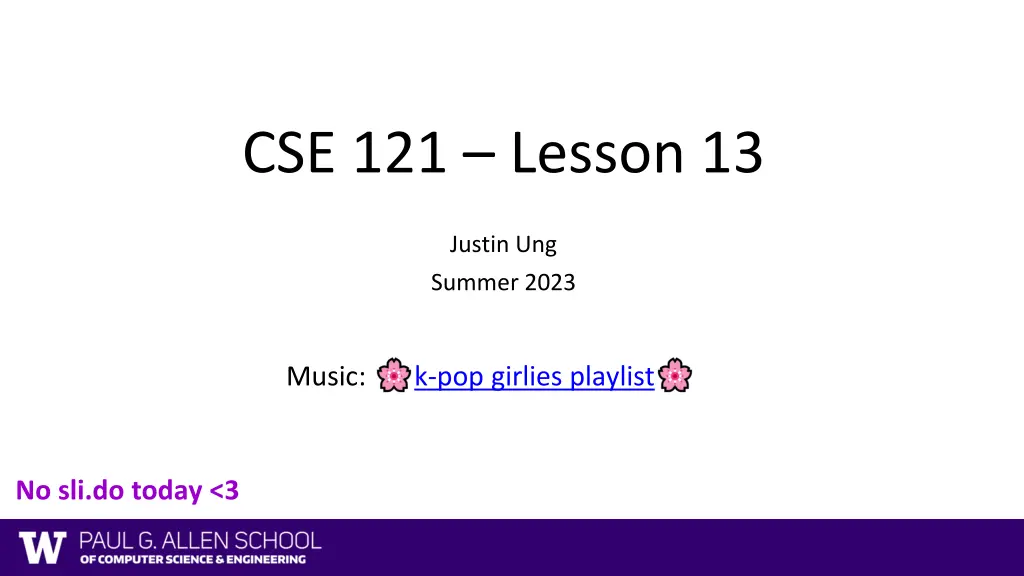
Understanding Programming Concepts Through Visual Art - CSE 121 Lesson 13
Explore key programming concepts illustrated through visually engaging images in CSE 121 Lesson 13, covering topics such as Value Semantics, Reference Semantics, Array Patterns, and Counting Elements. Get ready for your upcoming assignments and quiz while enjoying a K-pop playlist recommendation!
Download Presentation

Please find below an Image/Link to download the presentation.
The content on the website is provided AS IS for your information and personal use only. It may not be sold, licensed, or shared on other websites without obtaining consent from the author. If you encounter any issues during the download, it is possible that the publisher has removed the file from their server.
You are allowed to download the files provided on this website for personal or commercial use, subject to the condition that they are used lawfully. All files are the property of their respective owners.
The content on the website is provided AS IS for your information and personal use only. It may not be sold, licensed, or shared on other websites without obtaining consent from the author.
E N D
Presentation Transcript
CSE 121 Lesson 13 Justin Ung Summer 2023 Music: k-pop girlies playlist No sli.do today <3
Announcements, Reminders Programming Assignment 3 Its Data Time released, due next Tuesday Resub 4 due yesterday, Resub 5 out now due next Thurs Quiz 2 (Take-home): Monday Aug 7th(8/7) Topics: File I/O (Scanner, PrintStream), Arrays, Reference Semantics Reminder: Final exam Wednesday Aug 16 4:30 6:30 PM in PAA A102 Left-Handed Seating Request form posted on Ed due Aug 7th EOD 2
(PCM) Value Semantics vs. Reference Semantics Applies when working with primitive types Applies when working with objects Variables/parameters hold a copy of the actual value Variables/parameters hold a reference to the object 3
(PCM) Value Semantics vs. Reference Semantics int[] list1 = {4, 8, 15, 16, 23}; int[] list2 = list1; int a = 3; int b = a; a = 99; list1[1] = 99; 4
(PCM) Value Semantics vs. Reference Semantics boolean test = true; boolean[] tests = flipValue(test); {true, true, false, true, false, false}; flipValues(tests); public static void flipValue(boolean b) { b = !b; public static void flipValues(boolean[] b) { } for (int i = 0; i < b.length; i++) { b[i] = !b[i]; } } 5
(PCM) Counting Elements that Meet a Condition "one" "two" "three" "six" "seven" "eight" "ten" public static int evenLength(String[] list) { int countEven = 0; for (int i = 0; i < list.length; i++) { if ( ) { countEven++; } } return countEven; } 7
(PCM) Counting Elements that Meet a Condition "one" "two" "three" "six" "seven" "eight" "ten" public static int evenLength(String[] list) { int countEven = 0; for (int i = 0; i < list.length; i++) { if (list[i].length() % 2 == 0) { countEven++; } } return countEven; } 8
(PCM) Modifying Elements of an Array 4 8 15 16 23 42 public static void clamp(int min, int max, int[] list) { for (int i = 0; i < list.length; i++) { if ( > max) { = max; } else if ( < min) { = min; } } } 9
(PCM) Modifying Elements of an Array 4 8 15 16 23 42 public static void clamp(int min, int max, int[] list) { for (int i = 0; i < list.length; i++) { if (list[i] > max) { list[i] = max; } else if (list[i] < min) { list[i] = min; } } } 10
(PCM) Searching for an Element "one" "two" "three" "six" "seven" "eight" "ten" public static int indexOfIgnoreCase(String phrase, String[] list) { for (int i = 0; i < list.length; i++) { if ( ) { return ; } } return ; } Lesson 18 - Spring 2023 11
(PCM) Searching for an Element "one" "two" "three" "six" "seven" "eight" "ten" public static int indexOfIgnoreCase(String phrase, String[] list) { for (int i = 0; i < list.length; i++) { if (list[i].equalsIgnoreCase(phrase)) { return i; } } return -1; } 12
(PCM) Shifting Elements 9.6 -88.0 4.815 0.009 7.0184 42.9 public static void rotateRight(double[] list) { double lastElement = list[list.length - 1]; for (int i = list.length - 1; i > 0; i--) { list[i] = list[i - 1]; } } Lesson 18 - Spring 2023 13
(PCM) Shifting Elements 9.6 -88.0 4.815 0.009 7.0184 42.9 public static void rotateRight(double[] list) { double lastElement = list[list.length - 1]; for (int i = list.length - 1; i > 0; i--) { list[i] = list[i - 1]; } list[0] = lastElement; } 14
(PCM) Looking at Multiple Elements in an Array 0 1 9 1 0 public static boolean isPalindrome(int[] list) { for (int i = 0; i < list.length / 2; i++) { if (list[i] != list[list.length - 1 - i]) { return ; } } return ; } Lesson 18 - Spring 2023 15
(PCM) Looking at Multiple Elements in an Array 0 1 9 1 0 public static boolean isPalindrome(int[] list) { for (int i = 0; i < list.length / 2; i++) { if (list[i] != list[list.length - 1 - i]) { return false; } } return true; } 16
(PCM) Array of Counters or "Tallying" 8 3 0 1 2 2 0 7 2 public static int[] numCount(Scanner input) { int[] counts = ; while (input.hasNextInt()) { int num = input.nextInt(); } return counts; } Lesson 18 - Spring 2023 17
(PCM) Array of Counters or "Tallying" 8 3 0 1 2 2 0 7 2 public static int[] numCount(Scanner input) { int[] counts = new int[10]; while (input.hasNextInt()) { int num = input.nextInt(); counts[num]++; } return counts; } 18
(PCM) Common Ideas in Array Patterns Loop bounds Direction of traversal Indexing into an array 19
